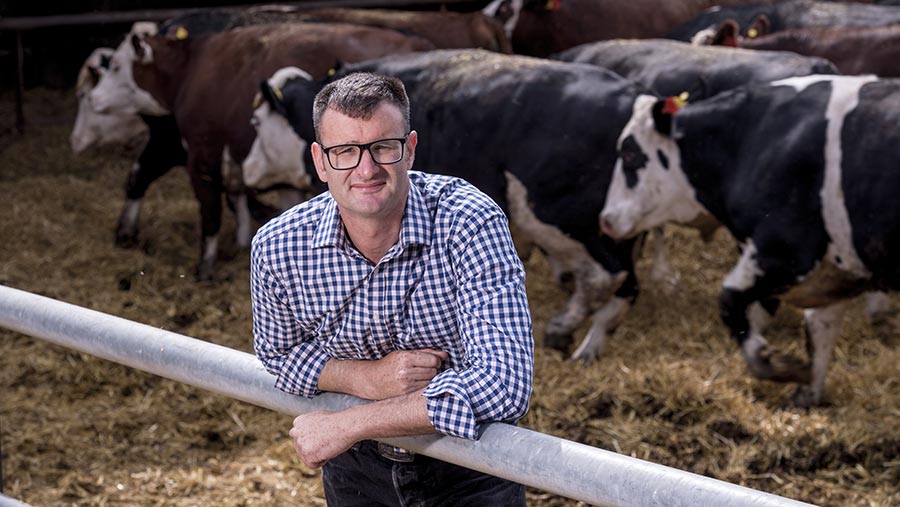Video: Finisher gives tips on selecting cattle for slaughter

© Jim Varney
Marketing cattle at the right time is not just about giving processors what they want, it’s about cost control and efficiency.
This is according to Yorkshire cattle finisher Doug Dear of Osgodby Grange, Selby, who says thin margins and limited space mean there is no point pumping feed into cattle that aren’t growing.
Margins have fallen from hundreds of pounds to tens of pounds over the past 10-15 years, so knowing when an animal is optimally profitable, rather than at its maximum weight, is important, explains Mr Dear.
See also: 2021 maize silage should feed well despite difficult start
“Keeping cattle on high-energy finishing rations when they aren’t putting on weight is expensive, and marginal kilos are often not cost-effective,” he says.
Mr Dear, who has run a custom feeding business in Yorkshire for 10 years, gives some tips on selecting finished animals.
Farm facts: D and P Custom Feeding
- Finishing 2,400 cattle annually
- Capacity for 800 head
- 566ha (1,400 acres) on a mixture of owned, farm business tenancies and contract farming
- Growing barley, wheat, oilseed rape and maize, and renting land out for potatoes
- Selling into nine processors and Thirsk and Selby markets
1. Pre-select
- When you think the cattle are ready, walk them from the pens into a sorting yard outside, and draft out stock that need more feeding
- Cattle often look different in the open air
- You can get a better sense of comparison when cattle are in the sorting yard
- This process can save time. Only 20 out of a pen of 40 might look close to being ready, so you’ve saved on putting 20 through the crush
2. Liveweight or deadweight?
- Markets tend to reward leaner steers and heifers with good conformation (E and U grades)
- Lower conformation R and O- suit the processors – dairy-cross animals are often ideal “factory cattle”
- Bulls must be under 16 months and have tighter weight limits if going deadweight
3. Processor specification
- Know the buyer, grid and payment schedule
- If you are unsure, ask the procurement agent to help select cattle
- Some processors with two sites have graders who give different results for the same carcass, so know your grader and which site the cattle are heading to
- A grader can vary by half a grade on the EUROP grid; some are very harsh on lean cattle, while some punish fat
4. Breed
- Angus Angus cattle can typically keep putting on finish. If in doubt, hold them another week
- Hereford If you think a Hereford or Hereford-cross is finished you are probably two weeks too late. Herefords grow well and stop gaining, so watch them closely
- Continentals It’s hard to get a good fat cover on continentals but they kill out about 60%, which is ideal for butchers and live markets. British Blues are the hardest to get fat on – it’s a compromise between carcass and finish
- Dairy-cross: Don’t try too hard to get dairy-cross animals to 680kg liveweight. If they are in specification at 320kg (kill out about 56%) deadweight then, providing they have a good fat cover, sell them
5. Gender
- Heifers often have 1.5-2% lower kill-out percentage than steers due to fat held in the udder and around internal organs
- Heifers start putting on fat much earlier than steers, so can be marketed 50kg earlier
- Bulls tend to kill out the best (this varies depending on breed) but have a 16-month age limit as prime cattle
6. Conformation
Cattle with good conformation look thickly fleshed and rounded, whereas O- and P grades look hollow and have bone structure clearly visible
- Round (hindquarter) Ranges from very rounded (E grade) through to a developed round (R grade) and poorly developed round (P grade)
- Loin Ranges from wide and very thick to narrow with visible bones
- Shoulder E grades are very rounded and Ps are flat with visible bones
7. Fat cover
Fat level can be assessed at the following places:
- Pin bones either side of the tailhead A 4L has a thin layer of fat either side of the tailhead which can be pinched between fingers and thumb. A 4H looks puffy and spongy
- Loin (transverse process) Slight pressure with the hand makes it feel slightly rounded. The more pressure needed to feel the bone, the fatter the animal. At 5H, the bone can’t be felt
- Ribs Should not be visible, but individual ribs should be felt with light pressure.
Good cattle crushes allow you to feel these areas, and, as you get more experienced, you can do it by eye.
Aim for cover on at least two out of three places to avoid overfeeding. Grab the brisket at the front of the animal, as this is often the last thing to flesh up. If it’s fleshy and firm, the animal is nearly done
8. Weight gain
- Animals that have been on feed for 90 days and are gaining only 1.1kg/day need to be sold as they are not putting on cost-effective gains
- Dairy-cross animals should gain 1.6-1.7kg/day and continentals and bulls can put on more than 2kg/day.
What is custom feeding?
- Two fees are paid – one covers all bedding and fixed costs, the other covers feed costs
- The Dears’ system typically works on feeding a finishing ration for 90-120 days
- Marketing can be done by the finisher, or the breeder can retain control of the process
- The farmer retains ownership of the cattle and is charged a finishing fee, and receives payment for the value of the cattle
- All feed is weighed in and weighed out of each pen through a feeder wagon to track customer costs. Two feeds of just under 13t fresh weight are fed daily. The system is accurate to within 0.05%
